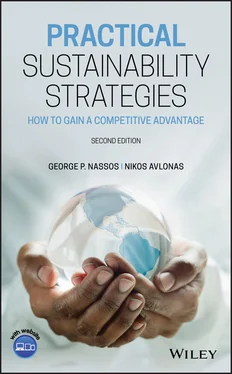1 ...6 7 8 10 11 12 ...18 The impact on the environment can also be presented as a mathematical relationship. For instance,

where EB is environmental burden; P is population; A is affluence; and T 1is technology.
Environmental burden refers to the negative impact on the environment, which is a function of (i) the population, (ii) affluence or consumption by this population, and (iii) technology that enhances or mitigates this impact. This formula can be restated as follows:

where T 2is the inverse of technology.
But now, the technology is what creates products and services sustainable. Population and affluence are really inversely proportional, as the population increases, consumption tends to decrease. As the people become more educated and consumption increases, the population tends to decrease. However, if the population was to double and the consumption was to, say, increase by 10-fold, technology would have to increase by 20-fold to keep the environmental burden constant.
The bottom lineto this discussion is that there is an urgent need for corporations, government agencies, non-governmental organizations (NGOs), and individuals to find ways to be sustainable and to implement them. Chapters 3– 17in Part 2will provide strategies for everyone, but for corporations in particular to develop, maintain, or extend a competitive advantage withouthaving a negative impact on the environment. Being more efficient in energy usage, water usage, natural resource usage, and creating less waste are all very, very important. These can all be classified as being less bad. However, being “LESS BAD IS NOT ENOUGH.”
While most corporations are very concerned with profitability, implementing sustainability does not necessarily mean an opposition to profitability. In fact, these two terms are complementary. By striving for corporate sustainability, the company will achieve long-term profitability. This is the goal for all corporate stakeholders, a term first used by multinational companies in the late 1960s and early 1970s, referring to all people and entities upon which the company has an impact. At the same time, the term Corporate Social Responsibility (CSR) was used to describe the process with an aim to embrace responsibility for the company's actions and encourage a positive impact through its activities on the environment, consumers, employees, communities, stakeholders, and anyone else in the public sphere who may also be considered as stakeholders. While this term was not widely used during the next three decades, it is currently used often to describe a company's integration of sustainability in its operations. Perhaps a more accurate name for the process would be Corporate Social Responsibility and Sustainability, or CSR and Sustainability as used by McDonald's Corporation [3].
In 2011, the European Commission defined CSR as “a concept whereby companies integrate social and environmental concerns in their business operations and in their interaction with their stakeholders on a voluntary basis” [4].
CSR concerns actions by companies over and above their legal obligations toward society and the environment. Certain regulatory measures create an environment more conducive to enterprises voluntarily meeting their social responsibility.
According to European Union (EU) policy, a strategic approach to CSR is increasingly important to the competitiveness of enterprises. It can bring benefits in terms of risk management, cost savings, access to capital, customer relationships, human resource management, and innovation capacity.
Because CSR requires engagement with internal and external stakeholders, it enables enterprises to anticipate better and take advantage of fast changing societal expectations and operating conditions. It can therefore drive the development of new markets and create opportunities for growth.
By addressing their social responsibility, enterprises can build long-term employee, consumer, and citizen trust as a basis for sustainable business models. Higher levels of trust in turn help to create an environment in which enterprises can innovate and grow. Through CSR, enterprises can significantly contribute to the European Union's treaty objectives of sustainable development and a highly competitive social market economy. CSR underpins the objectives of the Europe 2020 strategy for smart, sustainable, and inclusive growth, including the 75% employment target. Responsible business conduct is especially important when private sector operators provide public services. Helping to mitigate the social effects of an economic crisis, including job losses, is part of the social responsibility of enterprises. CSR offers a set of values on which to build a more cohesive society and on which to base the transition to a sustainable economic system.
CSR TODAY: FROM SHAREHOLDER VALUE TO STAKEHOLDER VALUE
Corporations today are being met by greater pressure from consumer and stakeholder groups to act upon societal and environment obligations. In essence, their actions are to mitigate the negative impact their activities are having upon the wider world. More and more, business leaders are themselves coming to the realization that their activities reach beyond the sphere of the business marketplace, impacting social, environmental, and political realms as well, and often negatively, and have implemented various measures, such as voluntary CSR reporting and recycling programs, to counteract the social and environmental tolls of global business.
With the rise of consumer education and activism, global social consciousness has become a hot topic of discussion, with business leaders jumping at the chance to exert themselves as champions of the people, and promote their businesses as “green” or “socially responsible.” And in the wake of a continually evolving set of ethical business guidelines comes the redefinition of the very concept of business . No longer is the “shareholder value prospect,” that is, maximum profit, the only player in the game, but its rival, CSR, a largely stakeholder and consumer concern, has emerged as the new MVP, or Most Valuable Priority. This reshuffle of priorities reflects the ability of globally responsible and creative business leaders to remain profitable while expending company resources toward the betterment of society, the transparency of business, and the protection of the environment.
Stakeholders—customers, employees of all ranks, suppliers, partners, affiliated institutes and governments, shareholders, and “owners”—represent the most fertile and diverse source of easily procured information available to a business or an organization. It should, therefore, come as no surprise that stakeholder engagement and dialogue is crucial for the profitability and continued existence of a company, as stakeholder opinions can be utilized to guide its vision and mission, and reflect on its performance. To simultaneously realize the potential of stakeholder groups, and to retain their valuable insights, a company must be willing to engage stakeholders in frequent dialogue, weigh their opinions, and allow them to participate in various decision-making processes. If this is not done, the company runs the risk of losing stakeholder capital—whether this is monetary, intellectual, or labor capital—which could prove potentially catastrophic to the life of the company in the long term.
Follow-up and feedback with stakeholders provide a cycle of opportunity for the growth and improvement of a company. Diverse stakeholder groups, when engaged in frequent dialog, can steer a company in a profitable and productive direction through the provision of perspectives on a variety of issues, from within a range of industries, geographic locals, demographic groups, and cultural backgrounds. For efficient and effective stakeholder dialog to be established, constant, clarifying communication between parties is essential, such as the identification of common goals among stakeholder groups and the company, as is the engagement and participation of stakeholders in relevant fora. Building relationships that transcend traditional business boundaries is a proven way to involve stakeholders in the mission of the company on a personal and emotional level, and evokes a genuine desire to learn from partnerships.
Читать дальше














